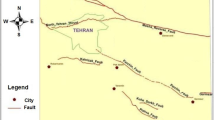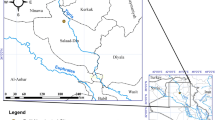Abstract
An assessment of radiological risk for the Pakistan Research Reactor (PARR-1) has been conducted using International Radiological Assessment System (InterRAS) code. The radiological risk assessment has been estimated by considering a hypothetical accident at PARR-1. The available nuclide for the hottest fuel rods has been determined by the depletion calculation of fuel using the ORIGEN 2.2 code. This work is focused on the implications of local metrological data and its use in decision-making to take urgent protective actions during the early phase of a nuclear emergency. The hourly meteorological ground-based data covering 3 years for Islamabad, Pakistan, has been analyzed and used to estimate the radiation doses for a hypothetical accident at PARR-1. A segmented Gaussian approach has been used to consider the variation in meteorological data. The direction, trajectory, maximum ground deposition, and the total effective dose equivalent (TEDE) corresponding to variable atmospheric stability classification, wind speed, and metrological conditions have been estimated. Results indicate that the differences in radiation doses at the same location for the same source term is due to the difference in the meteorological conditions. The maximum TEDE has been calculated as 6.90 × 103 mSv and 6.70 × 103 mSv at the distance of 0.1 km, with the maximum seasonal wind speed of 11.3 m s−1 and average seasonal wind speed of 3.3 m s−1 respectively. The maximum TEDE of 6.90 Sv has been evaluated for atmospheric stability class D. The radiological doses are less than ten mSv for all the classes and wind speed. The maximum dose has been found to be limited to less than 1.0 km from the point of release. Thus, at a distance of 0.75 km, the TEDE falls below the IAEA generic criteria of 100 mSv, established to take early protective and response measures in case of a nuclear or radiological emergency.














Similar content being viewed by others
References
Bijloos, G., et al.: Parametrization of homogeneous forested areas and effect on simulated dose rates near a nuclear research reactor. J. Environ. Radioact. 225, 106445 (2020). https://doi.org/10.1016/j.jenvrad.2020.106445
Bektaş, S.; Lüle, S.Ş: An integrated method for atmospheric dispersion and corresponding risks: application to ITU TRIGA Mark II research reactor. Prog. Nucl. Energy. 143, 104039 (2022). https://doi.org/10.1016/j.pnucene.2021.104039
Sato, Y., et al.: A model intercomparison of atmospheric 137Cs concentrations from the Fukushima Daiichi Nuclear Power Plant accident, phase III: Simulation with an identical source term and meteorological field at 1-km resolution. Atmos. Environ. X(7), 100086 (2020). https://doi.org/10.1016/j.aeaoa.2020.100086
Leadbetter, S.J., et al.: Ranking uncertainties in atmospheric dispersion modelling following the accidental release of radioactive material. Radioprotection 55(HS1), S51–S55 (2020). https://doi.org/10.1051/radiopro/2020012
Leelőssy, Á.; Lagzi, I.; Kovács, A.; Mészáros, R.: A review of numerical models to predict the atmospheric dispersion of radionuclides. J. Environ. Radioact 182, 20–33 (2018). https://doi.org/10.1016/j.jenvrad.2017.11.009
Aly, A.I.M., et al.: Dispersion modeling: methodology and new trends. Arab J. Nucl. Sci. Appl. 94(1), 36–45 (2016)
Leelőssyet, Á., et al.: Dispersion modeling of air pollutants in the atmosphere: a review. Cent. Eur. J. Geosci. 6(3), 257–278 (2014). https://doi.org/10.2478/s13533-012-0188-6
Benamrane, Y., et al.: Chernobyl and Fukushima nuclear accidents: what has changed in the use of atmospheric dispersion modeling. J. Environ. Radioact. 126, 239–252 (2013). https://doi.org/10.1016/j.jenvrad.2013.07.009
Ahangari, R.; Noori-Kalkhoran, O.: A study of the protective actions for a hypothetical accident of the Bushehr nuclear power plant at different meteorological conditions. Radiat. Environ. Biophys. 58, 77–285 (2019)
Aly, A.I.M., et al.: Assessment of dispersion characteristics and radiation doses consequences of a postulated accident at a proposed nuclear power plant. Eur. J. Acad. Res. V 10, 5887–5901 (2018)
Aliyu, A.S., et al.: Assessment of potential human health and environmental impacts of a nuclear power plant (NPP) based on atmospheric dispersion modelling. Atmosfera 28(1), 13–26 (2018)
Yoshikane, T.; Yoshimura, K.: Dispersion characteristics of radioactive materials estimated by wind patterns. Sci. Rep. 8, 9926 (2018). https://doi.org/10.1038/s41598-018-27955-4
Chen, S., et al.: The assessment and comparisons of RASCAL and EPZDose on atmospheric dispersion and dose consequences in radioactive material release accidents. In: EAFORM2017, 6th East Asia Forum on Radwaste Management Conference, 27–29November (2017)
Hussain, M., et al.: Estimation of intervention distances for urgent protective actions using comparative approach of MACCS and InterRAS. Sci. Technol. Nucl. Install. (2014). https://doi.org/10.1155/2014/874134
Korsakissok, I., et al.: Atmospheric dispersion and ground deposition induced by the Fukushima Nuclear Power Plant accident: a local-scale simulation and sensitivity study. Atmos. Environ. 70, 267–279 (2013)
Veleva, B., et al.: The Bulgarian Emergency Response System for dose assessment in the early stage of accidental releases to the atmosphere. J. Environ. Radioact. 100, 151–156 (2009)
Jeong, J.; Jung, W.: The estimation of early health effects for different combinations of release parameters and meteorological data. J. Korean Nucl. Soc. 33(6), 557–565 (2001). https://doi.org/10.1016/j.anucene.2010.03.007
Shamsuddin, S.D., et al.: Radioactive dispersion analysis for hypothetical nuclear power plant (NPP) candidate site in Perak state, Malaysia. EPJ Web Conf. 156, 00009 (2017)
Foudil, Z., et al.: Estimating of core inventory, source term and doses results for the NUR research reactor under a hypothetical severe accident. Prog. Nucl. Energy. 100, 365–372 (2017). https://doi.org/10.1016/j.pnucene.2017.07.013
Şahin, S.; Ali, M.: Emergency planning zones estimation for Karachi-2 and Karachi-3 nuclear power plants using Gaussian puff model. Sci. Technol. Nucl. Install. (2016). https://doi.org/10.1155/2016/8549498
Hussain, M. et al.: Estimation of Emergency Planning Zones (EPZs) for nuclear research reactor using plume dispersion code. In: Proceedings of the 2012 20th International Conference on Nuclear Engineering collocated with the ASME 2012 Power Conference ICONE20-POWER2012 July 30–August 3, 2012, Anaheim, CA, USA. https://doi.org/10.1115/ICONE20-POWER2012-54964
Jeong, H.J., et al.: Radiological risk assessment for an urban area: focusing on an air contamination event. Ann. Nucl. Energy. 37, 791–797 (2010)
Thiessen, K.M., et al.: Modeling the long-term consequences of a hypothetical dispersal of radioactivity in an urban area including remediation alternatives. J. Environ. Radioact 100, 445–455 (2009). https://doi.org/10.1016/j.jenvrad.2009.02.003
Cheng, Y.H., et al.: Development of accident dose consequences simulation software for nuclear emergency response applications. Ann. Nucl. Energy 35, 917–926 (2008). https://doi.org/10.1016/j.anucene.2007.09.001
Raza, S.S., et al.: Atmospheric dispersion modeling for an accidental release from the Pakistan Research Reactor-1 (PARR-1). Ann. Nucl. Energy 32, 1157–1166 (2005). https://doi.org/10.1016/j.anucene.2005.03.008
IAEA: Preparedness and Response for a Nuclear or Radiological Emergency. IAEA GSR Part 7. International Atomic Energy Agency, Vienna (2015)
IAEA: Arrangements for Preparedness for a Nuclear or Radiological Emergency, Safety Guide No. GS-G-2.1. International Atomic Energy Agency, Vienna (2007)
Hamid, T.: Reactor Kinetics Parameters as a Function of Fuel Burnup, PIEAS-445. Reactor Analysis Group, PIEAS, Islamabad (1999)
Bokhari, I.H. et al.: Thermal hydraulics and safety analyses for Pakistan Research Reactor-1 IAEA (1999). http://inis.iaea.org/search/search.aspx?orig_q=RN:35015936
Ali, M.R., et al.: Monte Carlo modeling of the Pakistan Research Reactor-1 (PARR-1). Ann. Nucl. Energy 87, 584–590 (2016). https://doi.org/10.1016/j.anucene.2015.10.015
Ullah, S., et al.: Source term evaluation for the upgraded LEU Pakistan Research Reactor-1 under severe accidents. Nucl. Eng. Des. 240, 3740–3750 (2010). https://doi.org/10.1016/j.nucengdes.2010.08.017
Mahmood, T., et al.: Performance evaluation/analysis of Pakistan Research Reactor-1 (PARR-1) current core configuration. Prog. Nucl. Energy 53, 729–735 (2011). https://doi.org/10.1016/j.pnucene.2011.04.003
Shaukat, N., et al.: Optimization of core reload pattern for PARR-1 using evolutionary techniques. Nucl. Eng. Des. 240, 2831–2835 (2010). https://doi.org/10.1016/j.nucengdes.2010.06.042
Croff, A.G.: A User’s Manual for The ORIGEN2 Computer Code, ORNL/TM-7175 (CCC-371). Oak Ridge National Laboratory, Oak Ridge, TN (1980)
Croff, A.G.: ORIGEN2: A versatile computer code for calculating the nuclide compositions and characteristics of nuclear materials. Nucl. Technol. 62(3), 335–352 (1983). https://doi.org/10.13182/NT83-1
Junfeng, L.; Zhongqi, S.: Introduction and use of InterRAS. Nucl. Eng. Technol. 23(1), 84–87 (2002)
Ramsde et al.: User Manual RASCAL Code 3.0 (2013)
IAEA-TECDOC, IAEA: 955: Generic Assessment Procedures for Determining Protective Actions during a Reactor Accident. IAEA, Vienna (1997)
Sehgal, B.R.: Nuclear Safety in Light Water Reactors: Severe Accident Phenomenology. Academic Press, Cambridge, MA (2011)
PAKMET: Pakistan Meteorological Department (PAKMET) hourly data for the years 2019–2021 for Islamabad, Pakistan (2021)
World Weather: Weather in Islamabad (2022). https://world-weather.info/forecast/pakistan/islamabad. Access on April 20th
WorldWeatherOnline. Islamabad Climate Weather Averages (2022). https://www.worldweatheronline.com/islamabad-weather-averages/islamabad/pk.aspx. Access on 20 April 2022
Ur Rehman, H., et al.: Environment friendly energy cooperation in neighboring buildings: a transformed linearization approach. Energies 15(3), 1160 (2022). https://doi.org/10.3390/en15031160
Mehboob, K.: Source term evaluation of a pressurized water reactor under different severe accidents. Ph.D. Thesis, Harbin Engineering university (哈尔滨工程大学), Harbin China (2012)
Mehboob, K.; Xinrong, C.: Source term evaluation of two loop PWR under hypothetical severe accidents. Ann. Nucl. Energy 50, 271–284 (2012)
Mehboob, K.; Xinrong, C.: Source term evaluation of two loop PWR under hypothetical severe accidents. Ann. Nucl. Energy. 50, 271–284 (2012)
Soffer, L., et al.: Accident source terms for light-water nuclear power plants. NUREG-1465. US Nuclear Regulatory Commission (1995)
USNRC: Alternative radiological source terms for evaluating design basis accidents at nuclear power reactors. Regul. Guide 1, 183 (2000)
Pasquill, F.: The estimation of the dispersion of windborne material. Meteorol. Mag. 90, 33–49 (1961)
USEPA: Meteorological Monitoring Guidance for Regulatory Modeling Applications, EPA-454/R-99-005 (2000)
ICRP: Low-dose extrapolation of radiation-related cancer risk. ICRP Publication 99. Ann. ICRP 35(4), 1–1400 (2005)
Sobue, T.: Scientific approach to radiation-induced cancer risk, influence on environment and health of radiation. Fukushima J. Med. Sci. 57(2), 90–92 (2012)
Acknowledgements
This research work was funded by the Deanship of Scientific Research (DSR), King Abdul Aziz University, Jeddah, under grant number (D-114-135-1443). Therefore, the authors acknowledge the DSR for technical and financial support. The authors also acknowledge the support provided by King Abdullah City for Atomic and Renewable Energy (K.A. CARE) under K.A. CARE-King Abdulaziz University Collaboration Program.
Author information
Authors and Affiliations
Corresponding author
Rights and permissions
About this article
Cite this article
Hussain, M., Mehboob, K., Ilyas, S.Z. et al. Implications of Local Scale Meteorological Data on Radioactive Plume Dispersion and Dose Delivery for a Hypothetical Severe Accident at PARR-1. Arab J Sci Eng 48, 739–755 (2023). https://doi.org/10.1007/s13369-022-06998-w
Received:
Accepted:
Published:
Issue Date:
DOI: https://doi.org/10.1007/s13369-022-06998-w




